
Setup and test results …
Now we come to the benchmark results. The test results for SATA3 drives are done with an ASRock 890GX Extreme3 motherboard for comparison and the test results for M.2 modules are done with an ASRock Z270 Taichi motherboard. Microsoft Windows 7 Ultimate Edition and Microsoft Windows 10 Enterprise Edition 64-bit are currently used as the operating system.
The following SSD benchmark software was used to check and compare the drive’s possible speed:
AS SSD Benchmark – Download
CrystalDiskMark – Download
HD Tach – Download
SiSoftware Sandra – Download
Windows Copy process
AS SSD benchmark results …
The AS SSD benchmark values offer a very good indication of the maximum possible read and write speed, the speed for smaller files and their respective access times. By the way, 4K means that small 4K blocks are read or written and this is distributed to 64 threads simultaneously in the 4K 64Thrd. Thus, the benchmark program simulates a typical program start, for example.
Extremely high sequential read and write speeds were achieved with the 2000GB Crucial M.2 P3 and P3 Plus. With the Crucial P3 PCIe Gen3 SSD, read was 2617 MB/s and write 2606 MB/s. The P3 Plus PCIe Gen4 SSD even achieved 3766 MB/s read and 3574 MB/s write. Thus, you can already see the clear advantage of PCIe Gen4 over PCIe Gen3.
In comparison, the Crucial P5 PCIe Gen3 2TB SSD was 2852 MB/s read and 2525 MB/s write. The Crucial P5 Plus PCIe Gen4 1TB SSD was at the highest performance to date of 5422 MB/s read and 4520 MB/s write.
By the way, the usable capacity of the Crucial P3 and Crucial P3 Plus M.2 is 1863.01 GB each. The Crucial P3 2TB M.2 NVMe achieves a whole 6866 points under Windows 10 due to the significantly higher 4K 64Thrd values and the Crucial P3 Plus 2TB is at 7630 points.
Here is a screenshot of the AS SSD benchmark scores (Crucial P3 vs Crucial P3 Plus 2TB M.2 NVMe Intel Windows 10 test system):
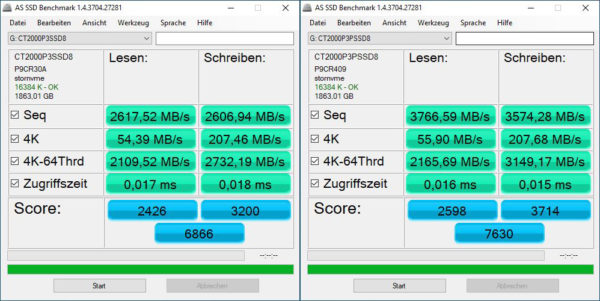
Here is another screenshot of the AS SSD iops results (Crucial P3 vs Crucial P3 Plus 2TB M.2 NVMe Intel Windows 10 test system):
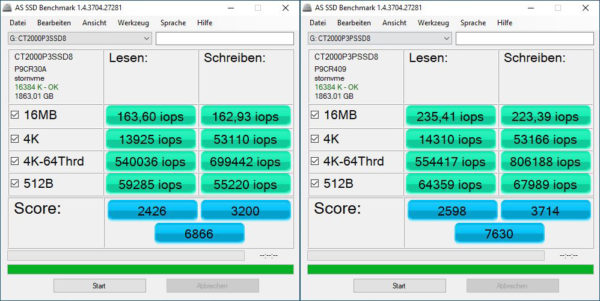
And here is a screenshot of the AS SSD copy benchmark values (Crucial P3 vs Crucial P3 Plus 2TB M.2 NVMe Intel Windows 10 test system):
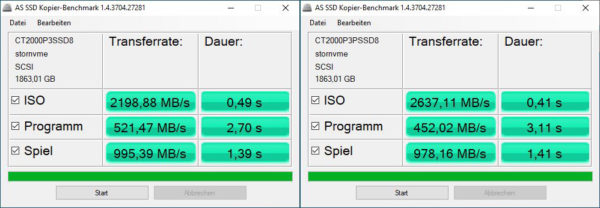
CrystalDiskMark results …
CrystalDiskMark also provides a balanced measurement of the performance with different transfer sizes.
As before, the P3 2TB achieves very good sequential read rates of 2233 MB/s and write rates of 2572 MB/s in addition to the 4K-64Threads rates. The P3 Plus 2TB achieves significantly better sequential read rates of 2635 MB/s and even write rates of 4336 MB/s.
Here is a screenshot of the CrystalDiskMark scores (left Crucial P3 vs Crucial P3 Plus right):
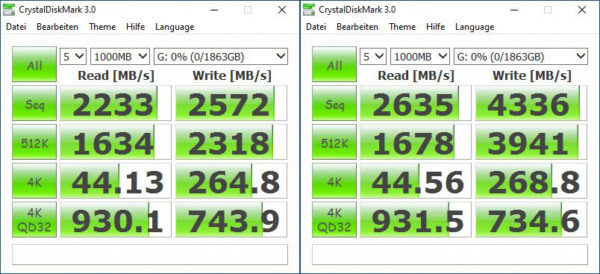
Since the version was kept the same for a comparison with the previous CrystalDiskMark scores, we additionally performed benchmarks with the latest CrystalDiskMark 8.0.4 x64 version. Here, the P3 2TB achieves very good sequential read rates of 3506 MB/s and write rates of 3246 MB/s. The P3 Plus 2TB achieves even better sequential read rates of 5059 MB/s and even write rates of 4406 MB/s. This even clearly exceeds the manufacturer’s specifications!
Here is a screenshot of the CrystalDiskMark 8 scores (Crucial P3 on the left vs Crucial P3 Plus on the right):
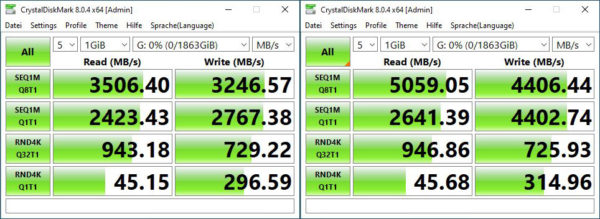
HD Tach results …
The HD Tach benchmark values show the course of the performance very well, but it is clearly different for an SSD than for a conventional HDD. Due to the new logical management of the SSD controllers when accessing the NAND cells, the values can fluctuate with the HD Tach version 3.0.4.0, which is designed for hard disks, like in similarly constructed SSDs.
HD Tach showed a short drop in the read performance of the Crucial P3, but it then remained even until the end. The Crucial P3 Plus 2TB M.2 SSD hardly showed any peaks in both the read and write processes and, like the P3, the lowest access time of 0.0 ms.
Here is a screenshot of the HD Tach benchmark values (left Crucial P3 vs Crucial P3 Plus right):
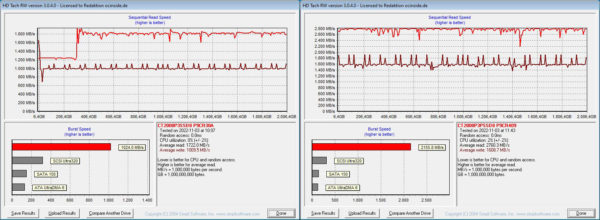
In order to see how the 176-layer 3D QLC NAND flash behaves with the used controller during a larger file transfer, we also executed the lengthy Long Bench. There were hardly any performance drops, which we usually know from QLC SSDs with longer write rates.
SiSoftware Sandra benchmark results …
Of course, the SiSoftware Sandra benchmark must not be missing in the test series. SiSoftware has had a very comprehensive tool on the market for a few years with the SiSoft Sandra program, with which you can get very reliable test results from all hardware components.
The average access time of the Crucial P3 2TB M.2 NVMe SSD was extremely low at SiSoftware Sandra with 4-6us and the drive index of up to 3.28 GB/s is a great value. The average access time of the Crucial P3 Plus 2TB M.2 NVMe SSD was also extremely low at SiSoftware Sandra with 5us and the drive index of up to 6.53 GB/s is a great value!
Here is a screenshot of the SiSoftware Sandra benchmark read values (left Crucial P3 vs Crucial P3 Plus right each read above, write below):
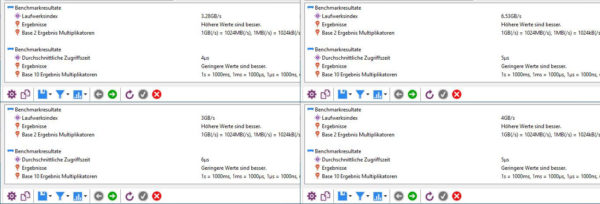
Windows copy benchmark results …
Even with longer and repeated benchmark runs, the determined measured values were constant. In addition, we also stressed the Crucial P3 and P3 Plus with common file copy processes. But even saving 1TB test files (1000GB) from the Crucial P3 Plus PCIe 4.0 x4 NVMe SSD to the Crucial P3 PCIe 3.0 x4 NVMe SSD, there was a continuous transfer rate of about 2.34 GB/s. When copying 1TB test file (1000GB) from the Crucial P3 PCIe 3.0 x4 NVMe SSD to the Crucial P3 Plus PCIe 4.0 x4 NVMe SSD, there was a continuous transfer rate of approx. 3.36 GB/s. Thus, there was no significant throttling of the speed!

Crucial P3 vs Crucial P3 Plus 2TB M.2 NVMe Result and general impression …

